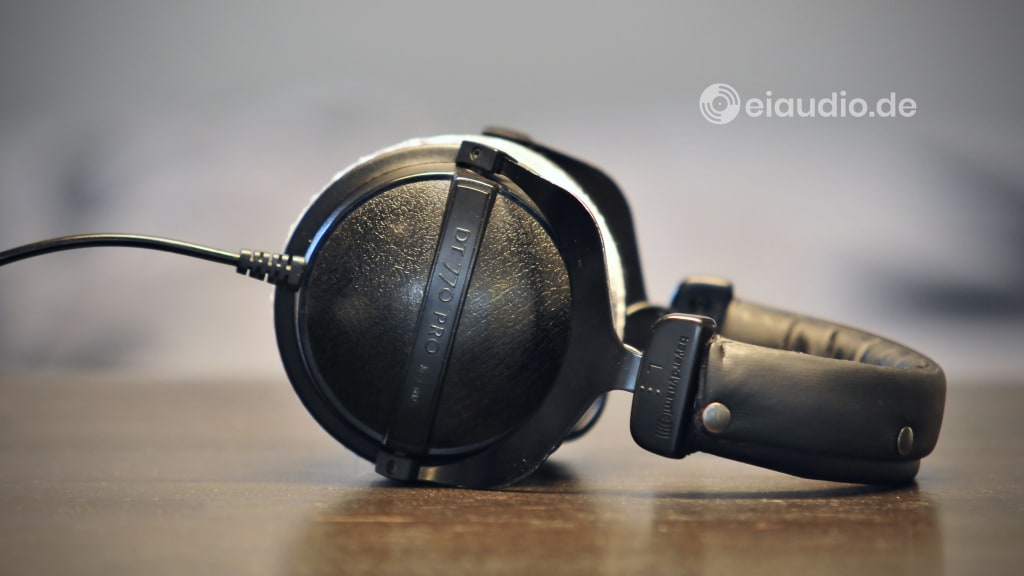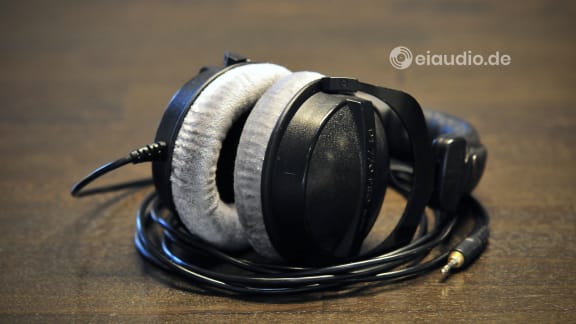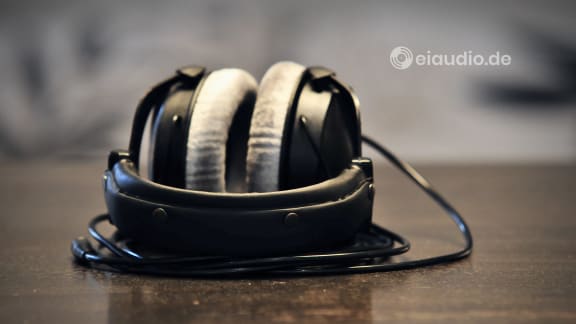Beyerdynamic DT 770 PRO
Published: 09/02/2023
Manufacturing date: 1985
Author: Karsten Hein
Category: Gear & Review
Tag(s): Headphones
I must confess that I had a relatively late start into the subject of headphones, simply because I had rarely worn them professionally, never managed to feel comfortable wearing headphones in public places, and always preferred the soundstage of our loudspeakers at home. This is not to say that I had never paid any attention to headphones. The first proper set of headphones I remember were my dad’s Panasonic studio monitors. They were of a closed-back design and had a second and softer inner ear pad that felt very comfortable. They cost some 300 dollars in the 1980s which was a lot of money back in the day, and—at least in my memory—they sounded great. My first own set of headphones had been the open back Sennheiser HD 580 Precision, and I remember being disappointed at how little they could do for me in terms of accurate bass. The Panasonics, by comparison, had bass performance so strong, they could hover over your head. Granted, this was probably an unhealthy experience to have.
The HD 580 Precision ended up sitting on the shelf for most of their existence, and it was not until late autumn 2021 that I became curious about headphones once again. A friend of mine had asked me to digitise his records for him, and I needed a good pair of headphones for monitoring and mastering. One of the people I interviewed before making my purchase decision was Jens, a part-time music producer, who recommended a set of tried and trusted AGK headphones to me, but, reading through the reviews online, I went for the 250 Ohms Beyerdynamic DT 990 PRO instead. 250 Ohms was the pro studio and audiophile standard, and I had read that, for a solid sound, decent headphones would require lots of clean power. So I bought a Douk Audio T-3 Plus tube headphone amp for them, which I soon upgraded with a wonderful set of GE tubes and a decent linear power supply.
Sadly, the Beyerdynamic DT 990 PRO turned out to be a disappointment to my ears. There was lots of bass, width, and dimension, and the highs were sufficiently articulate; however, I could not get over the fact that the highs and lows did not harmoniously connect with the midrange, which sounded rather muffled and overly dampened. The DT 990 PRO sounded far from linear on any of my music sources and were sorely lacking even when compared with the company’s higher-end gear, such as their flagship T-1 headphones. The latter was also the reason I decided to return the DT 990 PRO to the shop. A few weeks later, I found myself sending back a pair of AKG K702 headphones that were so obviously lacking in bass that just two hours of listening had prompted me to again read through the return policy.
I finally found happiness with a set of AGK 712 Pro which had a slight bass-boost to compensate for their open back construction. This made them sound tonally correct and, indeed, very similar to the tonally balanced sound that I had achieved on our audiophile stereo systems. The AGK 712 Pro were a true benchmark in their price category and had been my yardstick when comparing the sonic virtues of other headphones. Tonal correctness referred to the listener's ability to recognise the specific sound character of an instrument or a material, and it allowed music differentiation on a scale outside of volume, frequency, and rhythmic agility. For discerning listening, correct tonality played an equally important role as the other three dimensions, and this was also my reason for recommending the AGK 712 Pro to friends seeking price-conscious audiophile headphones.
All the more, I was surprised when my brother informed me that he had done some research and bought a number of Beyerdynamic headphones for the video mastering in his education programs. Jörg explained that his team needed closed back headphones that they could simply plug into their laptops and tablets without the use of additional amplifiers, and that the Beyerdynamic DT 770 Pro in their 16 or 32 Ohms version were well-equipped for the job. Without having listened to the headphones myself, I could not shake the feeling that what had alienated me from the DT 990 PRO might simply have been the Beyerdynamic ‘studio’ headphone sound. Had my brother run into the same trap that I had so readily trodded into when I first set out to purchase headphones for my mastering adventures? I sure did not hope so, and we agreed that he would lend me a pair for testing some time soon.
32 Ohms headphones—while perfectly suited for a low-output computer sound card—were not exactly ideal for a high-output tube headphone amp. And, while I was still contemplating how to set up my test in order to be fair to the Beyerdynamics, a friend from up our street mentioned that he had owned a pair of 80 Ohms DT 770 Pro for a few years, which he was still happy with, and that he would be honoured to lend to me for a test. I felt flattered by Erik’s willingness to support the eiaudio project and accepted his offer. And I was feeling even more flattered when I later learnt that Erik had fitted them with brand new silver-velour ear pads for the occasion. He had worn his DT 770 Pro for so many hours, the original silver velour colour had completely changed on his set. — And the Beyerdynamics were great when it came to parts replacements.
The original DT 770 had come out in early 1981 and had since become standard gear in many professional sound studios and for many musicians. The DT 770 PRO followed in 1985 but did not replace the DT 770 completely. People who have owned both the 81 and the 85 versions of the headphones reported that, except for the branding, there was little difference between them. Professionals in music have enjoyed the fact that Beyerdynamic headphones did not break easily and—if they should break—could be fixed cheaply and without much effort. Labelled 'hand made in Germany', the headphones used a combination of spring steel headband and forks with ear cups made of durable plastic. A simple stepped mechanism allowed the user to adjust the length of the headband in increments by pulling downward on the ear cups. Head pressure was perceived to be just right for long listening sessions. Although, on my heavily-used headphones, the adjusting mechanism had become slightly loose, the pressure on the head was still just right.
As on the DT 990 PRO, I enjoyed the generous size of the ear cups. From experience, I knew that this particular velour material could feel slightly warm and sweaty, especially when worn on hot summer days, but for the relatively modest price of the DT 770 PRO this was still more than fair. The ear cup forks were also made of spring steel and perhaps one of the reasons these Beyer’s stood the test of time. They allowed the head shells to swivel both horizontally and vertically to comfortably accommodate any head shape. Although I was wearing glasses during testing, I never felt them to be an inconvenience with these headphones.
The 80 Ohms version of the DT 770 PRO came equipped with a generous cable of just over three meters in length. While this would be sufficient for most studio applications, it could become a hindrance when using these headphones on the move. As far as non-detachable cables go, I much preferred the DT 770 PRO’s long and straight cable over the DT 990 PRO’s spiral cord. I also liked the fact that the cable felt quite sturdy being covered by lots of protective rubber. It was fitted with the typical straight 3.5mm TRS jack connector and offered threading for a 1/4-inch screw-on adapter. When it came to headphone cables, I personally preferred detachable cords as they were found on most of the headphones tested in this blog.
When I started listening to the DT 770 PRO on our tube headphone amp, I quickly understood that they were completely different from the DT 990 PRO that I had sent back in frustration one year earlier. The DT 770 PRO did not suffer from a muffled and seemingly unconnected midband, instead they sounded more compact and held the music together nicely. Our GE tubes had a sweet and harmonious top-end, and I found the Beyerdynamics to render this nicely. It was well possible that listening to these headphones with a transistor or less powerful amplifier would have produced a harsher result. Bass performance came across as slightly accentuated, especially when coming from an open-back design such as my AKGs, and yet, bass was neither boomy nor overly resonant with the ear cups.
The midband was not particularly strong but also not sharp or edgy. I had a sensation of a subtle sweetness when listening to both male and female voices on these headphones. The spacial separation between instruments was good for closed back headsets but not outstanding as far as headphones go. When switching to our 250 Ohms AGK 712 Pro, I was surprised to find that there was only a minimal difference in loudness between them. My brother had probably been well-advised to opt for the lower than 80 Ohms version for mixing on the computer, as I could see computer sound cards struggling to pump enough life into the Beyerdynamics. The DT 770 PRO did not clamp down on the ears and head as hard as the Sony MDR-7506 had done that I had tested earlier, but they also did not reach the level of tonal correctness and nuance that I was used to from the Sony and other higher-end models.
Current Headphone Ranking
- AKG K712 Pro (the most balanced and tonally accurate)
- Beyerdynamic T1 (nothing to complain about, except for the price)
- Stax New SR-3 (difficult to set up and operate, but sweeeet)
- Sony MDR-7506 (good monitor functions and natural tonality)
- Beyerdynamic DT 770 PRO (good monitor functions and cohesion)
- HiFiMAN HE-400i (balanced but a little on the bland side)
- AKG K702 (generally alright but unbalanced, leaning toward bright)
- Sennheiser HD 580 (sweet midrange, lacking precision and bass)
- Beyerdynamic DT 990 (pop-sound with muffled midrange)
While being sufficiently balanced and revealing for getting the mix right and for a joyful listening experience, the DT 770 PRO maintained a slightly closed-in soundstage and a tonal signature that was not quite on par with the more expensive models. The resulting shift could be described as transitory, perhaps. Considering how cohesively the DT 770 PRO performed on the whole, I could easily see this limitation as individual charm and would place the Beyerdynamics just under the Sony MDR-7506 from an audiophile perspective. However, if long-time wearing comfort or general studio usability also played a role in my rating, they would need to be positioned higher.
Further Reading:
< Douk Audio T-3 Plus & GE Tubes | Info on Linear Power Supplies >
Specifications
- Type: Stereo Headphones
- Design: closed back, bass reflex
- Ear coupling: Over-ear
- Frequency response (headphones): 5 - 35.000 Hz
- Nominal impedance: 80 Ohms (model tested)
- Available impedances: 16 - 250 Ohms
- Power sensitivity: 96,39 dB
- Power handling: 100 mW
- Harmonic distortion: < 0.2 dB
- Approximate pressure: 780 g
- Weight with cable: 350g
- Headphones without cable: 287g
- Cable type: single (straight), fixed
- Cable length: 315 cm
- Plug type: stereo jack, gold plated
- Plugs size(s): 3.5mm + 6.3mm jack
- Place of manufacture: Germany
- Predecessor: DT 770 (1981)
- Re-Design: DT 770 PRO X (2020)
- Year(s): 1985 - 2023





